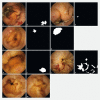CAD-CAP: a 25,000-image database serving the development of artificial intelligence for capsule endoscopy
- PMID: 32118115
- PMCID: PMC7035135
- DOI: 10.1055/a-1035-9088
CAD-CAP: a 25,000-image database serving the development of artificial intelligence for capsule endoscopy
Abstract
Background and study aims Capsule endoscopy (CE) is the preferred method for small bowel (SB) exploration. With a mean number of 50,000 SB frames per video, SBCE reading is time-consuming and tedious (30 to 60 minutes per video). We describe a large, multicenter database named CAD-CAP (Computer-Assisted Diagnosis for CAPsule Endoscopy, CAD-CAP). This database aims to serve the development of CAD tools for CE reading. Materials and methods Twelve French endoscopy centers were involved. All available third-generation SB-CE videos (Pillcam, Medtronic) were retrospectively selected from these centers and deidentified. Any pathological frame was extracted and included in the database. Manual segmentation of findings within these frames was performed by two pre-med students trained and supervised by an expert reader. All frames were then classified by type and clinical relevance by a panel of three expert readers. An automated extraction process was also developed to create a dataset of normal, proofread, control images from normal, complete, SB-CE videos. Results Four-thousand-one-hundred-and-seventy-four SB-CE were included. Of them, 1,480 videos (35 %) containing at least one pathological finding were selected. Findings from 5,184 frames (with their short video sequences) were extracted and delimited: 718 frames with fresh blood, 3,097 frames with vascular lesions, and 1,369 frames with inflammatory and ulcerative lesions. Twenty-thousand normal frames were extracted from 206 SB-CE normal videos. CAD-CAP has already been used for development of automated tools for angiectasia detection and also for two international challenges on medical computerized analysis.
Conflict of interest statement
Competing interests Dr. Saurin is a consultant for Capsovision, Medtronic, and Intromedic. Dr. Rahmi is a consultant for Medtronic. Dr. Leenhardt is cofounder and shareholder of Augmented Endoscopy, and has given lectures for Abbvie. Dr. Dray is cofounder and shareholder of Augmented Endoscopy and has acted as a consultant for Alfasigma, Bouchara Recordati, Boston Scientific, Fujifilm, Medtronic, and Pentax. Dr. Huvelin is a consultant for Medtronic.
Figures


References
-
- Iddan G, Meron G, Glukhovsky A et al.Wireless capsule endoscopy. Nature. 2000;405:417. - PubMed
-
- Rajpurkar P, Irvin J, Zhu Ket al.Chexnet: Radiologist-level pneumonia detection on chest x-rays with deep learningarXiv preprint arXiv:1711.05225 (2017)
-
- Chilamkurthy S, Ghosh R, Tanamala S et al.Deep learning algorithms for detection of critical findings in head CT scans: a retrospective study. The Lancet. 2018;392:2388–2396. - PubMed
LinkOut - more resources
Full Text Sources
Miscellaneous

